Ancient Roman Coins
The Roman Republic
The history of ancient Roman coins begins with the first old coins of the Roman Republic (c. 508-27 B.C. when Rome was ruled by its Senate). These were cast bronze coins – introduced during the third century B.C. and known as Aes Grave (heavy bronze). Before long, hand-struck Roman coins of various compositions appeared, which were issued through the remainder of the Republican era and well into the third century A.D. in the western half of the Roman Empire.
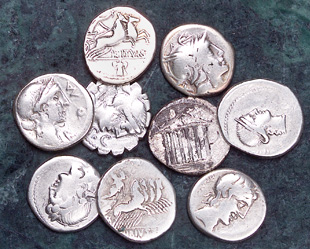
Hand-struck Roman Republic silver Denarii like these were produced between 154-41 B.C.
These hand-struck old coins included the gold Aureus, silver Denarius, bronze Sestertius, bronze Dupondius, and copper As – which often depicted mythological figures on issues of the Roman Republic, and usually depicted reigning leaders on Roman Imperial coinage. During the third century A.D., the silver Denarius was replaced by the "Double Denarius" now commonly known as the Antoninianus – which in turn was replaced during the 284-305 reign of Diocletian with such denominations as the silvered bronze Follis and the silver Siliqua (originally known as the Argenteus).
Pre-Imperial Coinage
The coins struck between the death of the dictator Sulla, 78 B.C., and the rise of Octavian (future Augustus) are transitional coinage, connecting the Republican and Imperial eras. During this time, bold generals raised huge armies, striving for the ultimate prize – power. One man, Julius Caesar (60-44 B.C.), rose from the chaos and brought an interval of stability, setting the Roman world on the road to imperial rule.

Julius Caesar financed his march on Rome by striking silver Denarii.
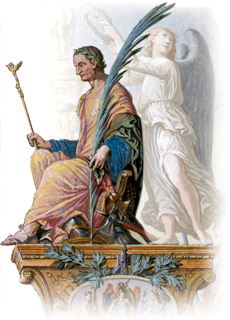
When Caesar crossed the Rubicon, marched on Rome and drove the great general Pompey into Greece, he financed this invasion and secured the loyalty of his troops by striking silver Denarii. These ancient Roman coins have his name and an elephant trampling a snake on the obverse. Many numismatists believe the snake represents Salus, god of safety, and the elephant represents Pompey. After Pompey's defeat, Caesar was appointed to the office of dictator, renewed annually. He was assassinated on March 15, 44 B.C.
The Roman Empire
The Roman Republican era ended and the Roman Empire began in 27 B.C. – when the Senate created the title of Augustus (emperor) for Octavian, granting him full authority over the entire empire. Most old coins of the Imperial era depict the reigning emperor on the obverse along with inscriptions identifying the ruler and his titles. These coins were often the only way to let the subjects know who was in charge and to some extent, what he looked like. The reverses of Roman Imperial coinage feature a wide variety of deities, mythological figures, military images, and symbols of authority.
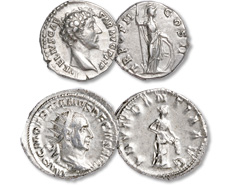
Most Roman Imperial coinage depicts the ruling emperor on the obverse. Shown here are a Marcus Aurelius silver Denarius (top) and a Trajan Decius silver Antoninianus.
Because there were no banks in ancient times, citizens and soldiers often buried coins to keep them secure – and fortunately for collectors today, many of those hoards were never retrieved. Roman Imperial coinage is still periodically unearthed in regions controlled by Rome in ancient times. Ancient Roman coins available today are from nearly 90 different rulers from the 27 B.C. – A.D. 14 reign of Octavian to the A.D. 284-305 reign of Diocletian – when ancient Rome split into eastern and western empires along Latin and Greek lines of influence and culture. Collectors of ancient Roman coins often seek coins depicting the most famous emperors – such as Octavian, Tiberius, Nero, Vespasian, Trajan, Hadrian, or Marcus Aurelius. Other collectors may specialize in the deities featured on the reverses of many different imperial coins – including Cybele the mother of all gods, Venus the goddess of love, Mars the god of war, or Minerva the goddess of wisdom.
Provincial Coinage
As Rome spread its influence and consolidated power, lands once held by barbarian tribes, independent city-states, and Hellenistic kingdoms fell under its authority. Because the Romans left local systems like religion, rulers and coinage in place, those areas all produced their own coins. These local coins, once struck at over 600 provincial mints, could circulate within a single city or across a region. Today, these coins make up the group known as Provincial coinage, which some collectors call Greek Imperials, and are a fascinating story in the history of ancient Roman coins. These coins can have legends in either Greek or Latin, sometimes both, because many of these areas were once part of the illustrious empire of Greece's Alexander the Great.
Provincial coinage has several features that make it very different from Roman Imperial coinage, which was issued regularly and had fixed denominations like the As, Sestertius or Denarius. Provincial coinage was issued sporadically with a wide variety of values following Greek denominations. At the empire's beginnings, mints in both the East and West struck coins for their own locales. But by the reign of Claudius, A.D. 41-54, as Roman Imperial issues spread, western Provincial coinage ceased. Eastern mints continued for another 200 years because a minting tradition passed down from Alexander the Great's successors was already in place.
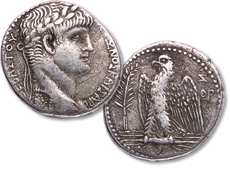
Nero silver Tetradrachm struck at Antioch, Syria – one of the mints that also produced the famous coins mentioned in the Bible.
Three of the greatest eastern mints were Antioch and Tyre in Syria, and Alexandria in Egypt. The Syrian mints produced the famous coins mentioned in the Bible, like the silver Tetradrachms and Tyrian Shekels. The mint at Alexandria, Egypt was founded by Alexander the Great and outlasted all other provincial mints. When Augustus defeated Antony and Cleopatra at Actium, Egypt became the personal property of the emperor. This rich country already had a coinage system that was "closed", meaning coins were struck and circulated only in Egypt. Future emperors maintained this system until Diocletian's reforms of A.D. 294. At that time, all Provincial coinage ended, and was replaced by Imperial issues.
The Fall of Rome
The history of ancient Roman coins grows more complicated as the ruling powers of the time began to shift. The Roman Empire was split into eastern and western empires under Emperor Diocletian (A.D. 284-305). Coins were then issued in the western portion until the forced abdication of power by Romulus Augustus in 476 brought an end to the Western Roman Empire. Completely different imperial coins were issued by rulers of the eastern portion, which continued to exist as the Byzantine Empire until 1453.
See our inventory of Ancient Roman Coins
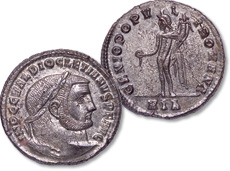
Diocletian bronze Follis, struck under Emperor Diocletian, who divided the Roman Empire during his reign.
Read more...

